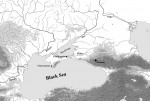 In the summer of 2004, the Krasnodar regional museum near the village of Mezmay in the Central Caucasus was notified of a site that had been looted on a large scale. Staffers reconnoitered the area and found an ancient necropolis disfigured by 100 pits dug by looters. Upon inspection of the spoil heaps (material discarded by looters), experts found artifacts of archaeological significance like iron spear-heads, two complete bronze helmets in pieces, an iron mace in the shape of a Tree of Life and a fragment from a gold torque.
In the summer of 2004, the Krasnodar regional museum near the village of Mezmay in the Central Caucasus was notified of a site that had been looted on a large scale. Staffers reconnoitered the area and found an ancient necropolis disfigured by 100 pits dug by looters. Upon inspection of the spoil heaps (material discarded by looters), experts found artifacts of archaeological significance like iron spear-heads, two complete bronze helmets in pieces, an iron mace in the shape of a Tree of Life and a fragment from a gold torque.
 The discoveries spurred systematic excavation of the one-acre necropolis. Archaeologists found six burials, three of them recently looted. The necropolis appears to have been in use from the 3rd century B.C. to the beginning of the 2nd century A.D. One of the three graves which had not been plundered has now been fully excavated and turns out to be the elaborate three-level grave of a high status warrior, probably a chieftain. It dates to the earlier period of the necropolis, the late 3rd century or early 2nd century B.C. The culture cannot be conclusively determined — the site is 2,600 feet above sea level in the Caucasus mountains, hard enough to reach that little archaeological exploration has been done — but it was certainly influenced by Hellenism even as it maintained its own particular traditions and practices.
The discoveries spurred systematic excavation of the one-acre necropolis. Archaeologists found six burials, three of them recently looted. The necropolis appears to have been in use from the 3rd century B.C. to the beginning of the 2nd century A.D. One of the three graves which had not been plundered has now been fully excavated and turns out to be the elaborate three-level grave of a high status warrior, probably a chieftain. It dates to the earlier period of the necropolis, the late 3rd century or early 2nd century B.C. The culture cannot be conclusively determined — the site is 2,600 feet above sea level in the Caucasus mountains, hard enough to reach that little archaeological exploration has been done — but it was certainly influenced by Hellenism even as it maintained its own particular traditions and practices.
The grave pit is 12.5 feet wide, 14 feet long and 8.5 feet deep today, although the ground has shifted and subsided over time. The first level has a large dolomite slab along the eastern edge. Remains of animal bones and pottery fragments found on the slab and around it suggest it was used as a table for a sacrificial funeral feast. The second level contains the bones of three horses and a cow. Iron bits, cheek pieces and one large bead were found on the remains of the horses, part of the tack they were buried with.
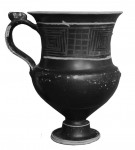 On the third level archaeologists found a layer of charcoal 2 inches thick. There’s no evidence of fire in the pit itself, so this charcoal must have been deliberately added to the cist. The remains of a wooden coffin, decayed into a few pieces of wood and some compacted decomposed timber, covered the skeleton of an adult male. Buried with him was a prodigious number of grave goods, concentrated at his head, chest and feet. Because it’s such an impressive collection of artifacts, here’s a full list of what was found in this warrior’s grave:
On the third level archaeologists found a layer of charcoal 2 inches thick. There’s no evidence of fire in the pit itself, so this charcoal must have been deliberately added to the cist. The remains of a wooden coffin, decayed into a few pieces of wood and some compacted decomposed timber, covered the skeleton of an adult male. Buried with him was a prodigious number of grave goods, concentrated at his head, chest and feet. Because it’s such an impressive collection of artifacts, here’s a full list of what was found in this warrior’s grave:
- two forged bronze helmets, one of which was initially on the head of the deceased
- a gold temple ring
- a black-glazed kantharos, or drinking cup
 an oval gold fibula brooch with a rock crystal bead mounted in the center, a tunnel was drilled through the middle of the bead from both sides
an oval gold fibula brooch with a rock crystal bead mounted in the center, a tunnel was drilled through the middle of the bead from both sides- a matched pair of round gold plaques with a hole in the middle
- an iron sword along the northeast wall
- a fragmented iron sword inside the left humerus
- a hollow gold bead near the left wrist
- three gold plaques of a type sewn to clothing found north of the elbow bone
- a short iron sword along the right elbow
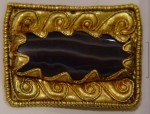 along the blade was a rectangular gold plaque mounted with a beautiful black patterned agate
along the blade was a rectangular gold plaque mounted with a beautiful black patterned agate- a gold bracelet found near the handle of the sword
- a bi-metallic fibula was in the shape of a Hercules’ Knot (a figure eight) found near the right radius
- a bronze cast mirror with a figured handle found in the pelvic area
- a pendant made from a chalcedony bead
- a gold button found on the chest near the spine
- a second gold button similar to the first found near the left humerus
- two gold buttons near the right shoulder
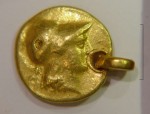 a pendant made from a gold coin from Sinope depicting Athena on one side and Nike on the other
a pendant made from a gold coin from Sinope depicting Athena on one side and Nike on the other- a cast glass semi-spherical bowl
- a cast glass skyphos or two-handled wine cup
- an iron axe
- a gold umbo-shaped plaque near the handle of the axe
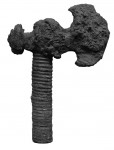 a long iron sword placed between the legs of the deceased with the sharp end pointed towards the pelvis
a long iron sword placed between the legs of the deceased with the sharp end pointed towards the pelvis- a round gold plaque with multi-colored inlay
- the vertical rod of an iron tripod decorated with figures of deer found under the blade of the sword
- two bowls found between the warrior’s legs
- a rolled-up piece of iron chainmail near the right shinbone
- underneath the chainmail were the ends of four long and three short spears
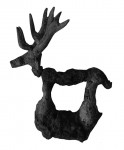 against the opposite wall, the iron ends of another two long spears and three short spears found fused together
against the opposite wall, the iron ends of another two long spears and three short spears found fused together- a large forged bronze basin turned upside down with fragments of iron tongs underneath
- a red clay kantharos with three handles
- a black-burnished lamp
- fragments of a bronze jug
- an unidentified object made from a piece of horn
- a bone knife found under the left shin
 the complete skull of an adult wild boar
the complete skull of an adult wild boar- a large wheel-turned jug
- one wheel-turned jug made of grey clay
- one wheel-turned kantharos with three handles also made of grey clay
- a penannular bronze bracelet
- an iron arrowhead
That’s more than a dozen gold artifacts, and the gold and agate plaque is unique. This is the first gold sword decoration ever discovered in this part of the world. Suck it looters!